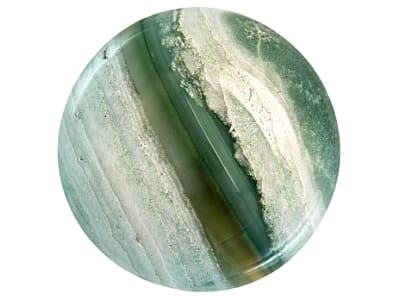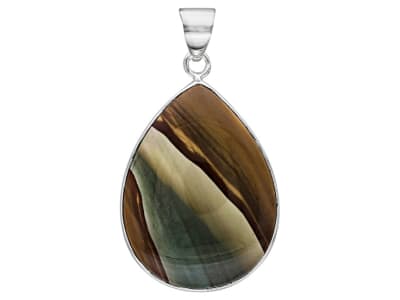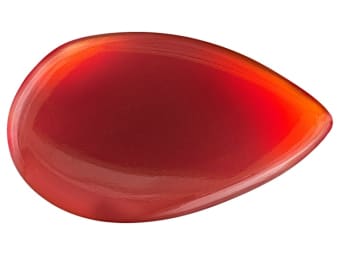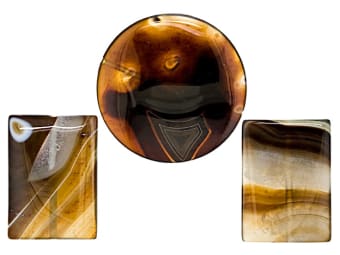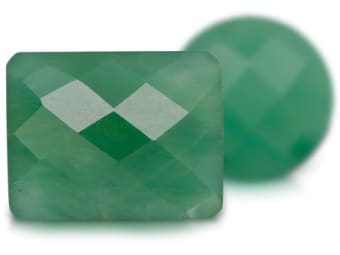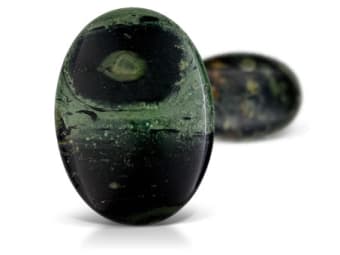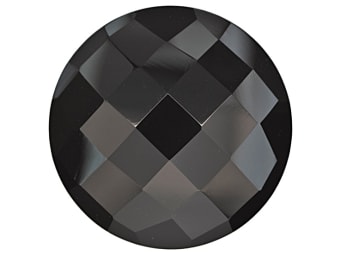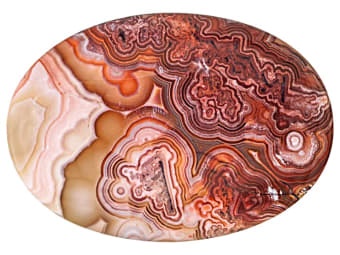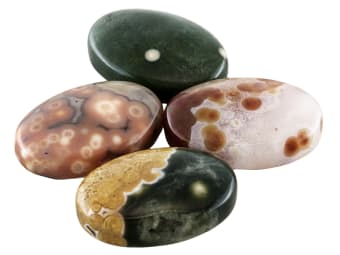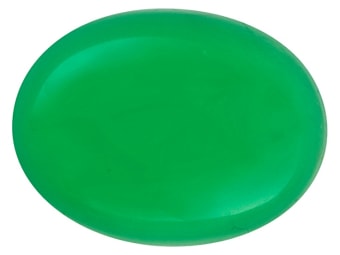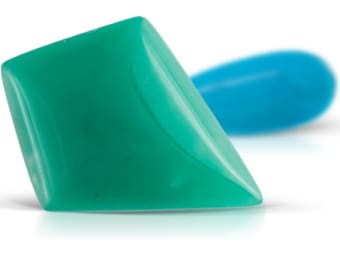Chalcedony is the microcrystalline (visible to the naked eye) or cryptocrystalline (visible with magnification) variety of quartz. Chalcedony can be separated into the translucent category known as agate and the opaque category jasper. Within agate and jasper there are numerous varieties that can be separated by color, appearance, and phenomenon. Some of the best-known chalcedonies are lace agate, bloodstone, carnelian, chrysoprase, and onyx.
General Information
LWUV: Inert
Chalcedony Colors
-
 Black
Black -
 Brown
Brown -
 Brown
Brown -
 Gray
Gray -
 Green
Green -
 Multi-color
Multi-color -
 Orange
Orange -
 Pink
Pink -
 Purple
Purple -
 Red
Red -
 White
White -
 Yellow
Yellow
Chalcedony Spectra
We acknowledge the significant scientific contributions of John S Harris, FGA to the study of gemstone spectra and with deep appreciation to him, acknowledges the use of his images and related notes about gemstones and their spectra in the educational materials on this website.
Countries of Origin
Papua New Guinea; Angola; Cambodia; Sudan; Kazakhstan; Paraguay; Portugal; Moldova (the Republic of); Greece; Mongolia; Morocco; Unknown; Mali; Panama; Guatemala; Guyana; Iraq; Chile; Argentina; Isle of Man; Ukraine; Belize; Zambia; India; Canada; Turkey; Belgium; Namibia; Faroe Islands; Finland; South Africa; Georgia; Jamaica; Peru; Turkmenistan; Venezuela (Bolivarian Republic of); Germany; Yemen; Tanzania, United Republic Of; Eritrea; Fiji; Viet Nam; Madagascar; Thailand; United Kingdom of Great Britain and Northern Ireland; Equatorial Guinea; Costa Rica; Sweden; Malawi; Liechtenstein; Poland; Bulgaria; Jordan; Nigeria; Croatia; Syrian Arab Republic; Sri Lanka; Uruguay; Timor-Leste; Kenya; Switzerland; Spain; Djibouti; Azerbaijan; Cuba; Mauritania; Guernsey; Congo (the Democratic Republic of the); Israel; Australia; Tajikistan; Estonia; Myanmar; Cameroon; Cyprus; Iceland; Oman; Bosnia And Herzegovina; Armenia; Austria; Mozambique; Korea (the Republic of); Luxembourg; Brazil; Algeria; Slovenia; Lesotho; Colombia; Ecuador; Hungary; Republic of Kosovo; Japan; Taiwan (Province of China); Bolivia (Plurinational State of); Lao People's Democratic Republic; New Zealand; Vanuatu; Senegal; Honduras; Italy; Antarctica; Ethiopia; Haiti; Afghanistan; Burundi; Russian Federation; Czechia; United States of America; Egypt; Saudi Arabia; Netherlands; Pakistan; China; Ireland; Slovakia; France; Serbia; Kyrgyzstan; Romania; Falkland Islands [Malvinas]; Togo; Philippines; Rwanda; Uzbekistan; Nicaragua; Norway; Botswana; Denmark; Dominican Republic; Mexico; Uganda; Zimbabwe; Greenland; Indonesia
Care
Normal care for untreated stones. Avoid heat for irradiated stones. Dyed stones avoid harsh chemicals, acetone, and ultrasonic cleaners. Some stones may fade in light or heat. Can be affected by perspiration.
Species/Variety
Carnelian
Carnelian is the orange to brownish red variety of chalcedony.
Sardonyx
Sardonyx is a form of onyx that is made up of bands of red sard and white chalcedony. Because of its banded patterns, sardonyx has been used for years in making cameos.
Chrome Chalcedony
Chrome chalcedony contains chromium, normally seen in the most coveted gems in the world; namely alexandrite, emerald and ruby. Present in small amounts, chromium gives these stones their unique shades of green, which have been compared to green seawater. Chrome chalcedony is usually untreated, as absolutely nothing is required to make this stone desirable! Although chrome chalcedony somewhat resembles chrysoprase in appearance, the two receive their color from two different elements.
Amethystine Chalcedony
Also referred to as "damsonite," amethystine chalcedony is an opaque to semi-translucent variety that is, you guessed it, purple. As chalcedony is technically a quartz, this gem is much like traditional amethyst and even can be heat treated to become a yellowish orange citrine color.
Plasma
Plasma is the term for a deep green chalcedony that often shows small yellow, red or white spots.
Black Onyx
Black onyx is chalcedony that has been dyed or sugar-acid treated.
Onyx
Agate
Agate is the term used to describe the translucent banded form of chalcedony. The term also covers included varieties like moss agate, dendritic agate and optical phenomenal varieties like fire agate and iris agate.
Jasper
Jasper is an opaque, fine grained species of chalcedony.
Chrysoprase
Chrysoprase is the apple green or yellow green variety of chalcedony.
Bloodstone
Bloodstone is a forest green jasper with bright red spots of iron oxide probably hematite.
Material Combination
Chrysocolla-In-Chalcedony
Chrysocolla forms as a decomposition product of copper minerals and frequently is intergrown with other minerals, in this case, with chalcedony. Also referred to as "gem silica," it is one of the rarest and most treasured variety of chalcedony. The gem may be seen in blue to blue-green color, and may be opaque to almost transparent.
